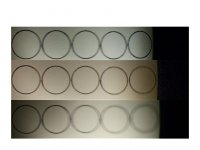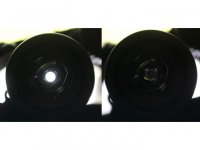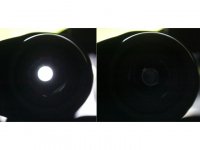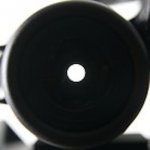henry link
Well-known member
This post is not a complete review. I borrowed a friend’s Swarivski 8x32 EL SV for the narrow purpose of objectively testing two characteristics that have been much discussed here: distortion and glare resistance.
To evaluate distortion I photographed a series of five circles through three binoculars with different distortion profiles. The circles represent about half of the right side of the fields with the dark field edge visible at the right. If angular magnification distortion (the stuff that causes the “globe effect” or “rolling ball”) is present it causes the circles to compress as they near the field edge, turning them into ovals, which resemble foreshortened circles rounding the side of a globe or ball.
As you can see the Swarovski 8x32 EL SV at the top shows much higher angular magnification distortion than the other two near the field edge, in fact at the very edge it’s higher than any other binocular I’ve seen except for other Swarovision models (I haven’t seen the Zeiss SF). In the middle is a Nikon 8x32 SE, another so called “flat field” design, which displays much milder AMD. The bottom binocular is a Zeiss 8x56 FL, which has enough pincushion distortion to essentially correct AMD so that circles remain circles all the way to the field edge. Sorry about the fuzzy circles in the Zeiss image. That’s astigmatism that can’t be focused out.
Pincushion distortion may be absent at the edge of the Swaro field, but it’s not completely absent in the overall distortion profile. Notice that the first three circles coming from the left side show no compression in the Swarovski compared to the Zeiss and actually a little less than the Nikon. That’s because the Swarovski follows the Zeiss approach in applying enough pincushion to avoid AMD over a large part of the field, then quite abruptly in the last 6-8º of apparent field the AMD comes on very strongly. The effect is less like rounding a globe and more like falling off the edge of a flat earth. This kind of compound distortion is sometimes called “moustache” distortion because it results in straight lines turning into wavy handlebar curves instead of the simple arcs produced by ordinary pincushion or barrel distortions.
Whether this kind of distortion is disturbing seems to be highly personal. It doesn’t bother me a bit, but a few here have reported that it made them hurl their cookies.
A couple of other things are visible in this image. One is the way apparent FOV is compressed in binoculars with high AMD. The five circles represent the very same size true FOV in all three of these 8x binoculars, but the compression of shapes toward the field edge in the Swaro and to a lesser extent the Nikon causes their apparent fields to shrink compared to a binocular with little or no AMD like the Zeiss. You can also see the relative differences in color bias among the three.
To evaluate glare resistance in the Swarovski I photographed the interior (middle image below) under two conditions designed to show internal reflections of the sort that cause visible glare. I also photographed the interior of a Zeiss 8x56 FL under the same conditions as a reference (far right image below).
The left photo in the Swarovski image is similar to the interior photos that appear in Allbinos reviews. A very bright entrance pupil (viewed through the eyepiece as the exit pupil) floods the interior with light, revealing most of the reflections that glance back toward the eyepiece, although sometimes the really bad ones right next the exit pupil may be lost in the bright light bleeding out from the overexposed exit pupil. Some of these reflections are quite harmless, either disappearing behind the field stop when the eye is at the correct eye relief distance or so far removed from the exit pupil that they never enter the eye even when the eye is dilated in low light. The potentially damaging ones here are the thin rings of reflection at the very edge of the exit pupil and the spots of reflection from prism edges just outside the rings. The three bright rings near the exit pupil come from the objective lens cell, the focusing lens cell and the first prism aperture.
In the right photo of the Swarovski image I placed a small dark object several feet in front of the binocular to darken the exit pupil while still allowing off-axis glare producing light to enter. This causes one of the lighting conditions where veiling glare is most troublesome: for instance, when the eye is open to perhaps 5mm or more while looking into a darkly shadowed area underneath a bright sky at sunset. As you see the internal reflections are actually much brighter than the dark “subject” being viewed. Looking through the binocular under these difficult lighting conditions produces severe veiling glare, but even while using the binocular normally in daylight I noticed occasional flickers of veiling glare under lighting conditions I would not usually consider very challenging. The Zeiss FL photos, made under the very same test conditions, show just how much better internal reflections can be controlled.
Henry Link
To evaluate distortion I photographed a series of five circles through three binoculars with different distortion profiles. The circles represent about half of the right side of the fields with the dark field edge visible at the right. If angular magnification distortion (the stuff that causes the “globe effect” or “rolling ball”) is present it causes the circles to compress as they near the field edge, turning them into ovals, which resemble foreshortened circles rounding the side of a globe or ball.
As you can see the Swarovski 8x32 EL SV at the top shows much higher angular magnification distortion than the other two near the field edge, in fact at the very edge it’s higher than any other binocular I’ve seen except for other Swarovision models (I haven’t seen the Zeiss SF). In the middle is a Nikon 8x32 SE, another so called “flat field” design, which displays much milder AMD. The bottom binocular is a Zeiss 8x56 FL, which has enough pincushion distortion to essentially correct AMD so that circles remain circles all the way to the field edge. Sorry about the fuzzy circles in the Zeiss image. That’s astigmatism that can’t be focused out.
Pincushion distortion may be absent at the edge of the Swaro field, but it’s not completely absent in the overall distortion profile. Notice that the first three circles coming from the left side show no compression in the Swarovski compared to the Zeiss and actually a little less than the Nikon. That’s because the Swarovski follows the Zeiss approach in applying enough pincushion to avoid AMD over a large part of the field, then quite abruptly in the last 6-8º of apparent field the AMD comes on very strongly. The effect is less like rounding a globe and more like falling off the edge of a flat earth. This kind of compound distortion is sometimes called “moustache” distortion because it results in straight lines turning into wavy handlebar curves instead of the simple arcs produced by ordinary pincushion or barrel distortions.
Whether this kind of distortion is disturbing seems to be highly personal. It doesn’t bother me a bit, but a few here have reported that it made them hurl their cookies.
A couple of other things are visible in this image. One is the way apparent FOV is compressed in binoculars with high AMD. The five circles represent the very same size true FOV in all three of these 8x binoculars, but the compression of shapes toward the field edge in the Swaro and to a lesser extent the Nikon causes their apparent fields to shrink compared to a binocular with little or no AMD like the Zeiss. You can also see the relative differences in color bias among the three.
To evaluate glare resistance in the Swarovski I photographed the interior (middle image below) under two conditions designed to show internal reflections of the sort that cause visible glare. I also photographed the interior of a Zeiss 8x56 FL under the same conditions as a reference (far right image below).
The left photo in the Swarovski image is similar to the interior photos that appear in Allbinos reviews. A very bright entrance pupil (viewed through the eyepiece as the exit pupil) floods the interior with light, revealing most of the reflections that glance back toward the eyepiece, although sometimes the really bad ones right next the exit pupil may be lost in the bright light bleeding out from the overexposed exit pupil. Some of these reflections are quite harmless, either disappearing behind the field stop when the eye is at the correct eye relief distance or so far removed from the exit pupil that they never enter the eye even when the eye is dilated in low light. The potentially damaging ones here are the thin rings of reflection at the very edge of the exit pupil and the spots of reflection from prism edges just outside the rings. The three bright rings near the exit pupil come from the objective lens cell, the focusing lens cell and the first prism aperture.
In the right photo of the Swarovski image I placed a small dark object several feet in front of the binocular to darken the exit pupil while still allowing off-axis glare producing light to enter. This causes one of the lighting conditions where veiling glare is most troublesome: for instance, when the eye is open to perhaps 5mm or more while looking into a darkly shadowed area underneath a bright sky at sunset. As you see the internal reflections are actually much brighter than the dark “subject” being viewed. Looking through the binocular under these difficult lighting conditions produces severe veiling glare, but even while using the binocular normally in daylight I noticed occasional flickers of veiling glare under lighting conditions I would not usually consider very challenging. The Zeiss FL photos, made under the very same test conditions, show just how much better internal reflections can be controlled.
Henry Link
Attachments
Last edited:









